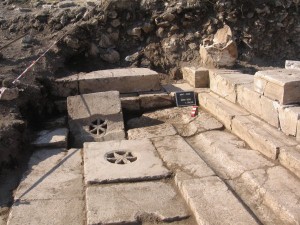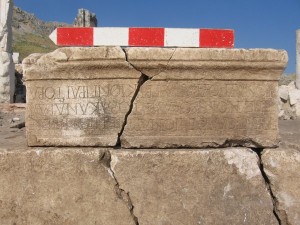The 2009 excavations in the Macellum (food market) started on July 5th. During this campaign, we are planning to uncover the north wing of the complex, including the north section of the central courtyard’s pavement, the north portico and possibly the main entrance of the building. After three weeks of excavations, a significant part of the central courtyard’s north east-corner has been explored. The excavations already produced some interesting results.
Prior to the excavations proper, a large amount of collapsed fragments scattered over the whole area needed to documented by our team of architects before their removal to the stone platform. Most of them belonged to the original elevation of the portico’s frontal colonnade. Architrave-frieze blocks, large cornice blocks, column fragments and pedestals formed the larger part of the removed material. The position in which they fell – some of them were still lying according to the sequence column-architrave-frieze-cornice – suggests that the north section of the Macellum collapsed in a south-easterly direction, following the natural slope of the terrace upon which the complex was built.

View of the north-east corner of the central courtyard, featuring the two star-shaped water evacuation openings
Underneath the collapsed debris, the north-eastern corner of the central courtyard was found in an outstanding state of preservation. The large slabs composing the limestone pavement were all found in situ, as well as the water gutter running along the portico’s staircase. Two star-shaped evacuation openings located in the corner must have evacuated rainwater to a subterranean drain, possibly the one traced in 2007 under the south portico of the Macellum.
The most interesting find of these first two weeks of excavation is an inscribed statue base found reused upside down on top of the portico’s staircase, where it was obviously recycled as a column pedestal. The text, referring to a personality of senatorial rank, reads as follows: “(Someone has honored) Tiberius Pollienius Armenius Peregrinus. He was quaestor as candidate (of the emperor), augur, patrician and praetor”. According to our epigraphist W. Eck (Universität zu Köln), the historical value of the inscription should be underlined. The family of the senator, who exercised the function of consul ordinarius in 244 AD, is known from two other documents found at Tlos and Xanthos in Lycia. The inscription found in the Macellum was certainly part of a larger ensemble of honorific statues that may have been displayed somewhere else in the city.



